R5 November Newsletter
|
The Region 5 Community Connector Newsletter Promoting activities, information, and news to the membership |
November 2023
|
Membership Contacts: |
Hunter J Boudreaux – East Area Chair
Maciej J Zawodniok– North Area Chair
Christopher B Sanderson– South Area Chair
Faye Kann– West Area Chair
R5 EXCOM Roster can be viewed here: https://rosters.ieee.org/home.html
|
R5 2023 EXCOM Meetings |
- IEEE Region 5 2023 Winter EXCOM Meeting and Audit Committee Meetings: The meeting was held on Friday Jan 27 – Sunday Jan 29, 2023 at Courtyard Marriott Springfield Airport, 3527 W Kearney Street, Springfield, Missouri, United States, 65803.ExCOM recommended Christopher Sanderson and Kenneth Rice for the R5 Director-Elect Candidates. There could still be a petition candidate, thus, this is not the final candidates slate for the Director-Elect position.
- 2023 Region 5 Annual Meeting and Student Competitions was held on Friday April 21,22 & 23 at the Hyatt Regency Aurora-Denver Conference Center, 13200 E. 14th, Aurora, CO 80011. More meeting details and highlight coming soon.
-
Region 5 Fall ExCom Meeting: Region 5 held their annual fall Executive Committee meeting in San Antonio, TX from October 13-15, 2023, in partnership with Southwest Research Institute and Lone Star Section. The group met to review 2023 activities and strategic planning for 2024-25 activities. The student branch members from the University of Texas at San Antonio presented during the lunch hour about their 2023-24 activities. Garrett Hall who is the student advisor was in attendance.
San Antonio Councilwoman Adriana Rocha Garcia provided very timely remarks on STEM activities for youth and job growth in her district which adjoins Southwest Research Institute. IEEE was pleased to have her join us on Friday and share future strategies.
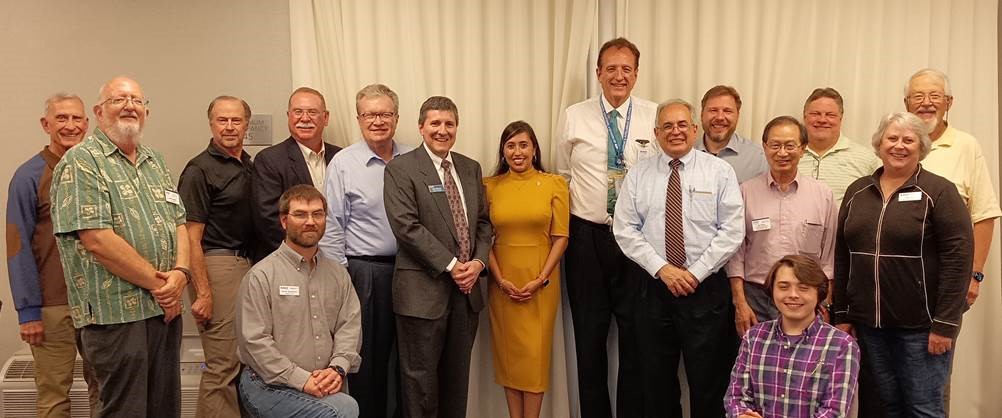
Starting from the left is Bill Wylie, Larry Larson, John Reinert, Clif Denny, Walt Downing, R5 Director 2022-2023 Bob Becnel, San Antonio Councilwoman Adriana Rocha Garcia, Nils Smith, Jose Navarro, R5 Director 2024-25 Matt Francis, Kai Wong, Don Dunn, Faye Kann, Jim Sipes and with Hunter Bordeaux and Case Kirk in front.
|
R5 2023 Committee |
- Treasurer: Paul Cassingham.
- Audit Committee Chair, 4th Year: William Wylie (North) Billwylie@ieee.org
- Audit Committee, 3rd Year: Silke Spiesshoefer (East) Silke_Spiesshoefer@ieee.org
- Audit Committee, 2nd Year: Ernest X Njouondo (South) njouondo@ieee.org
- Audit Committee, 1st Year: Patterson, Tristan Hunter (West) tristanpatterson10@hotmail.com
| Spotlights |
Senior Member Upgrade Event Quite Successful
IEEE Central Texas Section hosted an event, on August 29 at the Balcones Country Club in Austin, Tx to help qualified IEEE members apply for upgrade to Senior Member. In response, 33 IEEE CTS members showed up for help with a normally confusing and arcane process. The event was directed by James Mercier, the Senior Member Upgrade Coordinator for both CTS and Region 5. James is also the R-5 Representative on the IEEE Advancement and Upgrade committee.
The meeting started with dinner provided by CTS and an explanation of what is expected in the Professional Experience and Significant Performance sections of the application. James laid out the formats expected in these sections and the reasons for them. The applicants began working on the application on the laptops and notebooks they had been instructed to bring.
Assisting James were 9 Senior Members, (four of whom were recently upgraded Senior Members) Hari Ranganathan, Vaishali Mane, Gopal Pagrut, and Uday Kanike. Having recently been through the process, they gladly volunteered to help the new applicants. The other 5 were Larry Larson, CTS Chair, Andrew Bluiett, CTS Vice-Chair, Martha Dodge, CTS Secretary, Steve Pearson, (PI)2 Past Chair, and Chris Sanderson, R-5 South Area Rep, who drove up from Houston. All the volunteers brought their expertise to guide the applicants in the proper explanation of their experiences. Getting the applicants to work as a group alongside each other improved the communication because if someone asked a question the answer was heard by all.
The next step will be for each applicant to email the worked-on application to James for review and approval. If approved, the candidates will upload the on-line application and James will select and assign the Reference Writers for each application.
This was the first Senior Member Upgrade event in over 4 years. James feels that we may go back to having the these on a regular basis now that we have a suitable venue. Submitted by James Mercier jmercier@ieee.org
New Studies Show Wildfire Smoke Could be a Stumbling Block for Solar Energy Generation
Picture below: Dr. Long Zhao and his graduate student, Amjad Ali, are shown here on the campus of South Dakota Mines during their research examining the impact of wildfire smoke on solar energy generation.

Wildfire smoke may have a significant impact on the efficiency of solar panels and the overall effort to transition nation’s energy production from fossil fuels to more solar based systems, according to research published by Long Zhao, Ph.D., an assistant professor in the Department of Electrical Engineering and Computer Science at South Dakota Mines and director of the Smart Grid and Energy Research Lab at South Dakota Mines.
Zhao’s work, conducted over the last two years when wildfire smoke blanketed parts of the American West, shows that widespread smoke can reduce the output of individual solar panels by nearly 50% — even on days when smoke is present at high altitudes and air quality near the ground is not significantly impacted.
“It depends on where you are,” says Zhao. It makes sense that solar energy production is negatively impacted on very smoky days, but Zhao’s team was surprised to see reductions in solar energy output when wildfire smoke was aloft higher in atmosphere. “This makes it harder to quantify days when smoke will impact solar energy production based on air quality monitoring systems we have in place,” he says. His work will be published in the Journal IEEE Transactions on Industry Applications.
Unlike passing clouds, that can reduce solar energy generation for a short duration, wildfire smoke can settle over a region for an extended period. This summer, for example, saw thick layers of Canadian wildfire smoke inundate the East Coast of the United States. “I think one special thing about wildfire smoke is it can travel thousands of miles and cover lots of land mass and last for days or even weeks,” says Zhao.
Furthermore, smoke from wildfires often varies in intensity with pockets of heavier and lighter coverage that can cause fluctuations in solar panel output. Zhao calls these fluctuations “the wiggle effect,” and he described this phenomena in a paper published by IEEE that was shared in the publication IEEE Spectrum. “These fluctuations can have a significant impact on our power supply if we are relying on solar systems as a major part of our energy grid,” says Zhao.
Electric grids across the nation operate on thin margins between supply and demand, and Zhao’s work shows fluctuations in solar energy generation caused by wildfire smoke could be enough to destabilize parts of the grid that are more reliant on solar power. In California, for example, the U.S. Energy Information Administration reports that 25% of all electricity in 2022 was solar generated. Across the United States, 92.5 gigawatts were generated by solar systems in the same year. Zhao’s research shows that as the country moves toward more reliance on solar generated electricity, wildfire smoke must be a factor taken into consideration.
“Bigger photovoltaic systems will have bigger problems with the wiggle effect,” Zhao says. “We have not yet seen widespread problems because we do not yet have solar widely installed across the country. As we move to rely on more solar power in the future, and as wildfires continue, this is going to be a serious problem we need to address.”
Inspiring employment opportunities for EE students
On September 25, 2023, SDSMT IEEE PES chapter and SDSMT student branch sponsored a session on inspiring future employment opportunities for EE students. They shared information on how to transition from university student to working engineer. An Ulteig intern, Theron Kalasinsky, who is attending SDSMT shared his comments on internship projects that have made an direct impact on the company activities. Dr. Long Zhao, chair of the PES chapter, sponsored the session. Students in the local power and energy class were able to ask questions and interact with the recent graduates. Thanks to Ulteig for allowing their employees to share information about the innovative, employee-owned company. Here is a link to Ulteig https://ulteig.com/

Pictured [starting on the right] are Dr Long Zhao, SDSMT assistant professor and PES/IAS joint chapter chair Julianna DeLong-Unruh, graduate EE at Ulteig and alumni of SDSMT Ethan Unruh, design engineer at Ulteig and alumni of SDSMT EE Student attending SDSMT
Pikes Peak LMAG Meeting – October 23, 2023
The Pikes Peak LMAG celebrated its Global LMAG Achievement Award with an in-person meeting held at Macaroni Grill in Southwest Colorado Springs on October 23. The meeting was attended by 11 LMAG members and 6 guests including Faye Kann, Region 5 West Area Coordinator. After ordering our meals, the group introduced themselves to each other. Once the meal was served, we began the panel discussion on “Silicon Mountain”. The Chair, David Bondurant, explained that Silicon Mountain was the name of Colorado Springs during the 1970s, 1980s, 1990s and early 2000s. We no longer use this name but we are somewhat in a resurgence with the Chip Act encouraging an $800M expansion of Microchip Technologies and a Swiss company planning to expand the old Intel fab with $480M investment in a solar panel manufacturing operation. The panel will review the foundations of Silicon Mountain starting in the 1970s.
Ford Microelectronics: Steve Barton was working at Intel Corporation in late 1970s when Ford Motor Company decided to develop microprocessors for engine controls. He was involved with development of 8096 microprocessor design for Ford. This was early in microprocessor era and Ford’s demand for 5M microprocessors in one year was too much for Intel. Ford decided to develop a captive semiconductor company to build the processor in 1982. It was initially housed in Ford Aerospace facility in Colorado Springs before their own building was complete a couple of years later. Steve moved to Ford to complete the project. Ford built a $33M GaAs manufacturing facility to serve military & aerospace business at 9965 Federal Drive in 1985. In 1999, Ford closed the manufacturing line but kept an 80-person design team. The manufacturing facility was acquired by Intel in 2000.
Inmos Corporation: Don Carrigan started at TI but later worked for NCR Microelectronics in Colorado Springs briefly. He told the story of the founding of Inmos where he was one of the first 39 employees. Inmos was founded by Dr. Richard Petritz, John Heightly, and Paul Schroeder. Dr. Petritz had been VP of Research at TI when he founded Mostek, a leading DRAM company in Dallas. Paul Schroeder was a key DRAM designer. They were looking to start a new company. They met Ian Barron, an English microprocessor developer. He was able to help them raise $120M to found Inmos Corporation with plan to develop memory and microprocessor products. The memory company was located in Colorado Springs at a new facility near Quail Lake. Inmos developed 64K & 256K DRAMs. Their 256K was the first 256K CMOS DRAM and the fastest DRAM available by early 1985. By 1984, Inmos was losing money due to Japanese entry into DRAM market so company was sold to Thorn EMI, then ST Microelectonics. Ultimately the facility was closed and later sold to Cray Computer. The DRAM design team moved to Ramtron, a Colorado Springs startup. Others from Inmos founded Simtek, a non-volatile SRAM company.
Mostek, United Technologies, UTMC, Aeroflex, Cobham, Frontgrade Technologies: John Reinert started at Motorola and later moved to NCR Microelectronics in Colorado Springs. In 1979, Mostek, the world leader in DRAMs, decided to build a major DRAM factory in Colorado Springs. John went to work for them in Product Engineering. Mostek successfully manufactured 64K and 256K DRAM in the facility but were under financial pressure due to Japanese entry into the DRAM market. Mostek was sold to United Technologies. They were a major aerospace company. They had developed a United Technologies Microelectronics Center (UTMC) next door to the Mostek fab. When UT/Mostek was sold to STMicroelectronics, John moved to UTMC which built high reliability & radiation hard semiconductors. The UT/Mostek fab would be sold to Rockwell International who would expand it. They would then sell to Intel Corporation. UTMC would become Aeroflex, Cobham, and finally Frontgrade Technologies continuing as a leading supplier of military and aerospace electronics.
NCR Microelectronics: Gene Freeman worked at NCR Microelectronics early in his career. NCR created NCR Microelectronics in Colorado Springs in 1975 to build DRAMs for their computer business. They would ultimately license 16Kb DRAM from Mostek and build them at a factory near the Colorado Springs Airport.
Gene told the history of NCR as a mechanical calculator company in Dayton, OH. They had difficulty adapting to emerging world of electronic calculators and computers due to their mechanical focus. They would ultimately significantly downsize their operation in Dayton, diversify manufacturing around the country. NCR Microelectronics was part of the diversification.
NCR Microelectronics would build DRAM, Microprocessors, and Complex I/O chips. The local company would become AT&T, Symbios Logic, LSI Logic, Avago, and Broadcom. The manufacturing facility became Dpix and InnovaFlex Foundry .
Contributed by David Bondurant: IEEE Pikes Peak Section Chair, IEEE Pikes Peak LMAG Chairman. IEEE Life Member Committee – LMAG Activities Coordinator dbondurant@ieee.org
The IEEE High Plains Section event:
VIBRATING GLOVES COULD BE GAME-CHANGER FOR PARKINSON’S PATIENTS, was held at Loveland, CO, at the DeskChair Workspace on October 19, 2023.
Parkinson’s Disease affects approximately 1 million Americans, half of whom are undiagnosed. There is no cure and existing treatment effectiveness declines as the disease progresses. Recent research at Stanford University has shown promise in using specific patterns of vibration applied to the fingertips to provide a lasting reduction in symptoms without the typical side effects of medication. This talk will cover an introduction to Parkinson’s disease, describe the Vibro-tactile Coordinated Reset (VCR) research and results obtains by Dr. Peter Tass at Stanford, and efforts by a group, of which I am part, to replicate the Stanford research to benefit our friends and family. Several iterations of the hardware for the electronics, vibrating tactors, and the gloves that couple the vibration to the patient’s fingertips was shown. This includes 3D printing of finger “cups” to hold the vibrating tactors, wired and wireless versions of the control electronics and a unique solution to obtain sub-1millisecond timing accuracy across a Bluetooth connection linking a pair of wireless VCR gloves.
The presenter is an IEEE member with High Plains Section. Mr. Doug Bartlett has his MSEE & BSEE from Purdue University with a specialization in Solid State Devices. 30 years of experience in VLSI design & CAD tool development and management at Hewlett-Packard, Intel and Avago. Technologies (now Broadcom). 6 years of experience as VP of Engineering / CTO at two tech startups in the IoT/Wearables space. 4 years of consulting and software development in embedded systems development for digital health products.
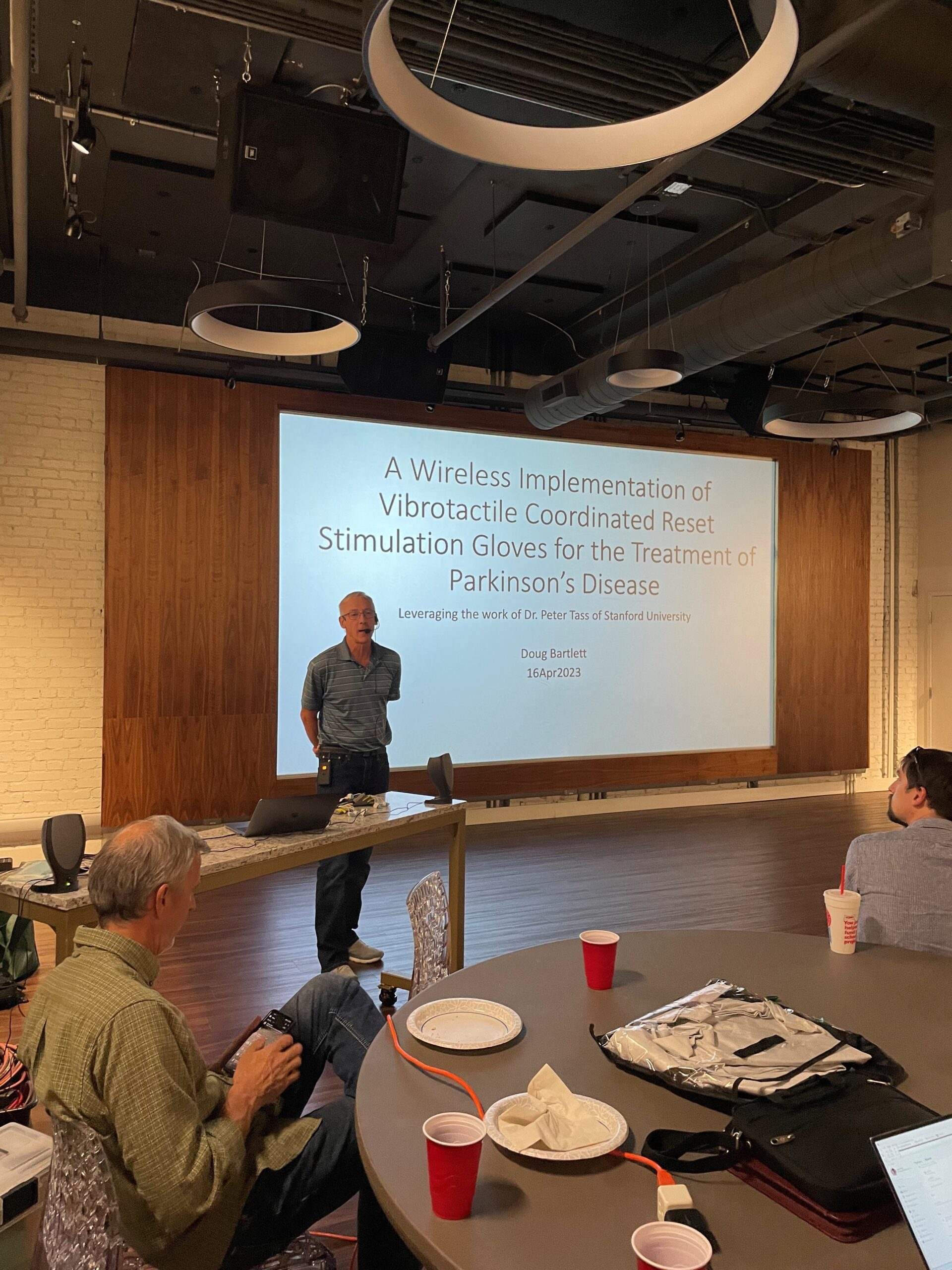
The IEEE High Plains Section has been very active with several meetings per month and actively participating in student activities with Colorado State University. Section members are shown below starting on the right with Faye Kann, West Area Chair and member of Black Hills Subsection and Kris Waage, Section Chair. Mike Houvis, Richard Toftness, xx xx , Pete O’Neill, Doug Bartlett, xxx xx
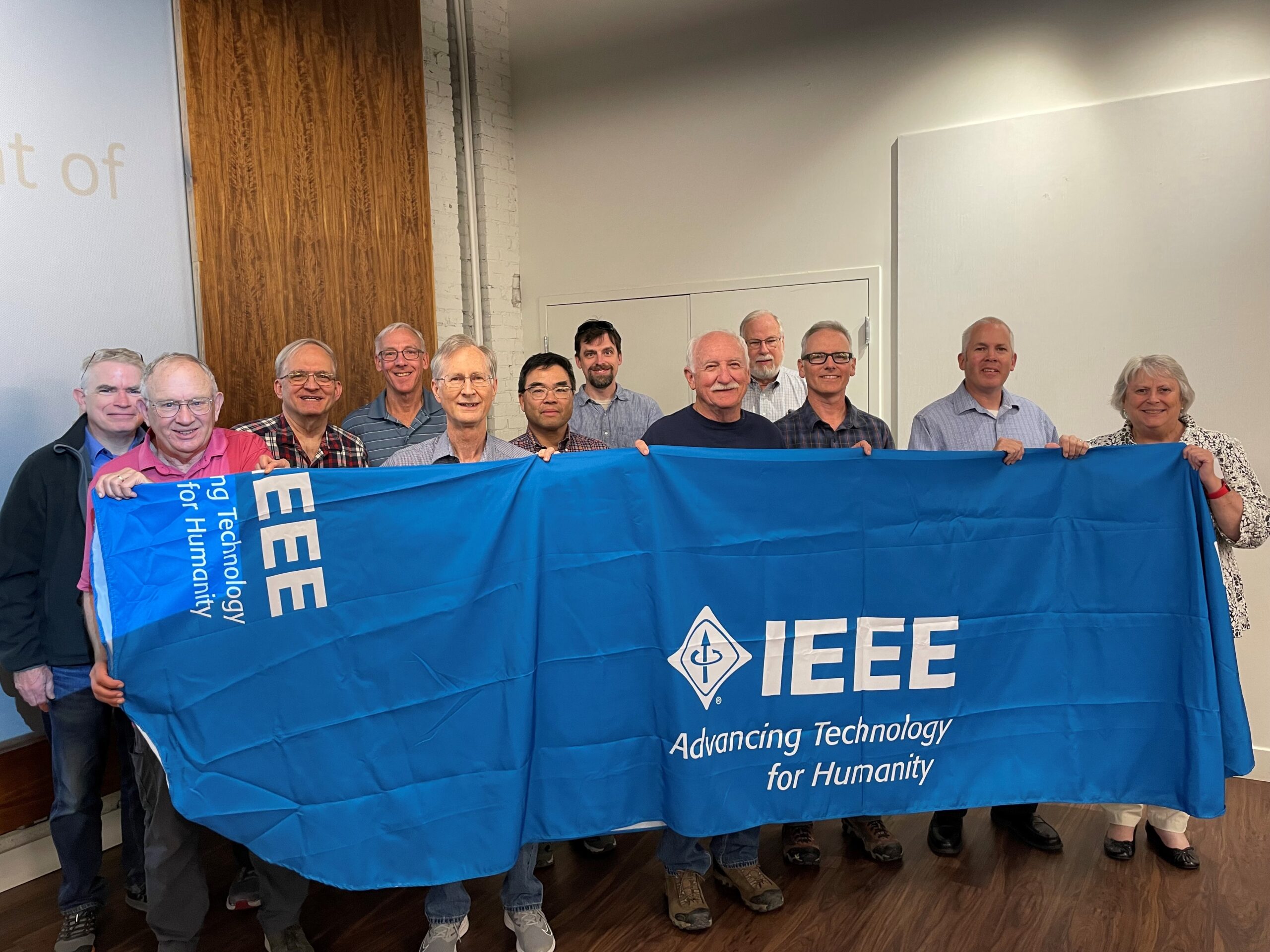
The meeting was held in the community meeting room at DeskChair Workspace in Loveland. The building was converted from an old bank building on Loveland’s main street. The space offers entrepreneurs and small business owners with unique space needs on friendly terms and ability to customize the space. https://deskchairworkspace.com/workspaces/office-space/found that many
IEEE High Plains Section Officers are shown below at the October 18 meeting. Starting on the left is Pete O’Neill, Treasurer; MS Kumaran, CSU Student Officer; Faye Kann, West Area Chair and member of Black Hills Subsection; Kris Waage, Chair; and Richard Toftness, Secretary.
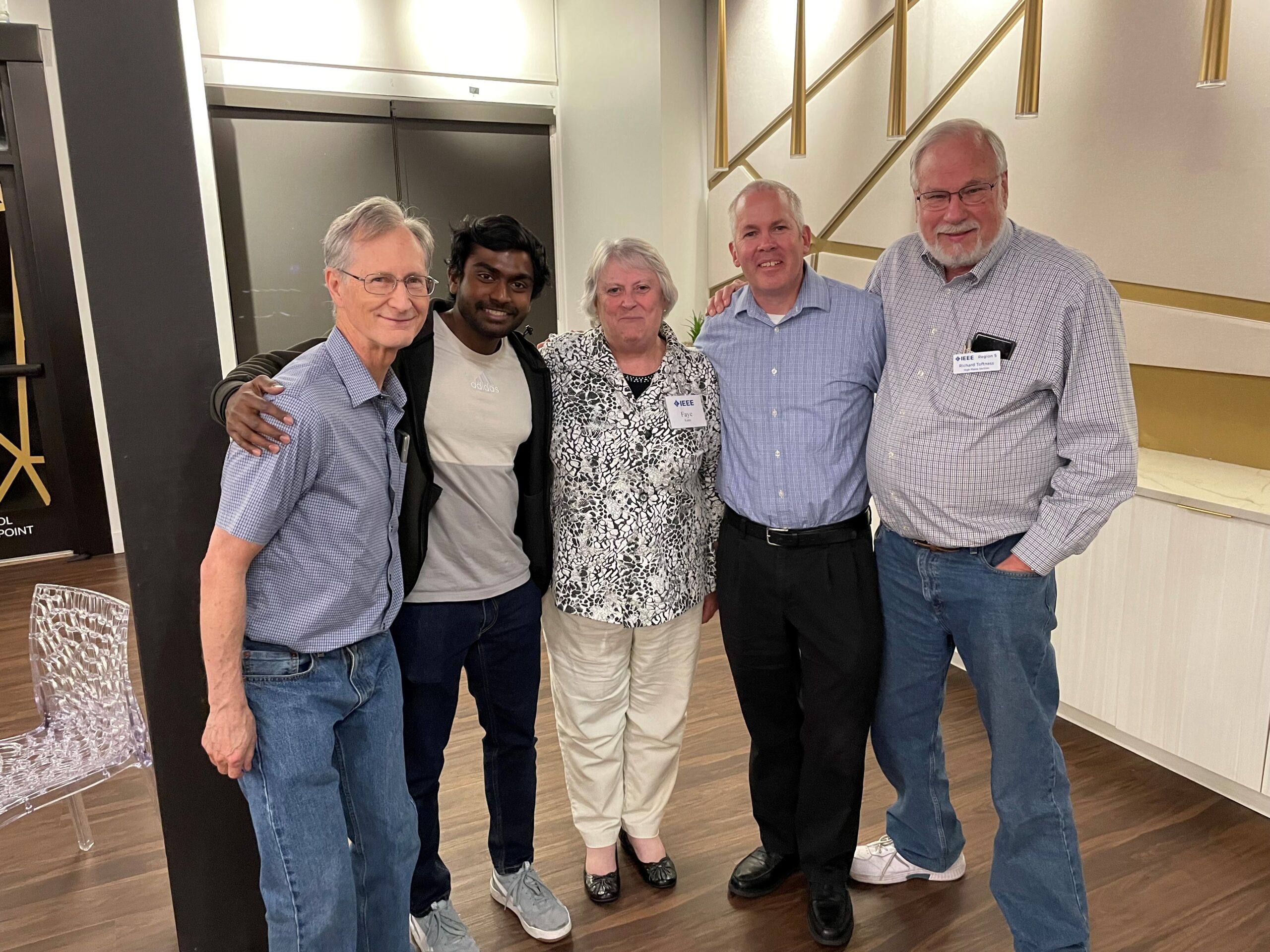
Pikes Peak Joint Electron Devices/Circuits & Systems Chapter Reactivates on Silicon Mountain
The Pikes Peak Joint Electron Devices/Circuits & Systems Chapter held it’s first meeting in four years on the University of Colorado-Colorado Spring campus on October 26, 2023. The Chapter was founded in 1981 to focus the growing semiconductor industry on Silicon Mountain. The industry hit some hard times in the 1980s and 1990s as some manufacturing plants were closed. Silicon Mountain is seeing a resurgence of activity recently as the result of the Chip Act.
David Bondurant, Pikes Peak Section Chair, talked to a group of 27 members of the Chapter and UCCS students and members of the student branch. His topic was “Non-volatile RAM for the Internet of Things (IoT)” which describe the status of the Ferroelectric RAM, Magnetoresistive RAM, and Resistive RAM technology and products and why non-volatile RAM was perfect for Internet of Things applications.
This talk was particularly significant since the Ferroelectric RAM first was developed in the UCCS Microelectronic Laboratory by Dr. Carlos Araujo and Dr. Larry McMillan who founded Ramtron in 1984. Colorado Springs was also home of Simtek, a developer of the non-volatile SRAM. Both companies were acquired by Cypress Semiconductors which is now owned by Infineon Technologies. Non-volatile RAM products continue to be developed today by Infineon on Silicon Mountain. The speaker is a former VP of Marketing at Ramtron and Director of Marketing at Everspin Technologies. He worked for Ramtron, Simtek, Freescale & Everspin Technologies, leaders in three non-volatile RAM companies.
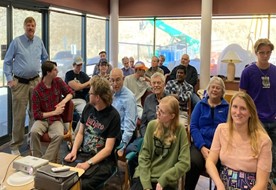
Pikes Peak Section Chair David Bondurant addresses the group
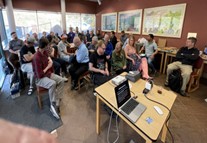
27 Chapter members and UCCS Student gather for presentation
| Community Outreach |
Project Self-Sufficiency (PSS)
Project Self-Sufficiency (PSS) evolved from the efforts of a countywide task force in 1985 to coordinate and expand services for low-income, single-parent families. One of the most promising pathways out of poverty includes access to higher education. Today, our local programs are offered to 105 families concurrently. PSS breaks new ground with single-parent families to access their self-power. PSS provides educational and career empowerment through 1:1 coaching, goal reinforcement, and significant support helping single parents cut through the stress and barriers to their success to self-power their completely new life.
PSS receives donated laptops & computers from banks, hospitals, and local commercial businesses. We refurbish those donations for participants’ academic use by installing current Windows operating systems, and applications and performing performance testing.
Volunteering at PSS is an excellent way to give back to your local community. For Members and Student Members, the commitment would be about 4 hours a week,
Right now, there is an immediate need in the Weld and Larimer County area of Northern Colorado, but there may also be a need in your immediate area.
If you live in the Northern Colorado area and are interested in volunteering,
please contact: Diane Glessner, Project Self Sufficiency, IT volunteer dianelee.glessner@gmail.com
| Membership Development |
New to IEEE? Want a refresher on the benefits of your membership?
Go to www.ieee.org/start for a step by step approach to maximizing your membership benefits.
After a short introduction video, this site contains a summary of the many benefits of being an IEEE member including Technical Content, Networking, Career Resources, help in finding local activities, Discounts, and Humanitarian and Philanthropic Opportunities. Check it out and MAXAMIZE you membership!
Not an IEEEE Member? Have you been waiting for the right time to join?
Join the IEEE this month and receive 14 months of the benefits of being an IEEE member for the price of 12. Go to www.ieee.org/join to begin receiving all the benefits of being an IEEE member NOW.
IEEE is the world’s largest technical society, bringing members access to the industry’s most essential technical information, networking opportunities, career development tools, and many other exclusive benefits. To find out more, go to www.ieee.org/membership
Opportunity to make a difference as an Engineer!
As an IEEE member, or simply as an Engineer, we get the opportunity to make a difference in the lives of future engineers AND have some fun at the same time!
Science Fair Judge – Yes it is science fair season again! There are a number of science and engineering focused schools in the Region 5 area that host science fairs each year. Most will be hosting fairs over several days this year. Typically, they start in December with a local fair, move to a regional based fair in the Feb/March time, and then onto a state level competition. Those winners then go to ISEF, the Regeneron International Science and Engineer Fair. This is the world’s fair of science fairs. In 2024, ISEF will be held in Los Angeles, CA May 11-17.
If you look, there will probably be many local Science Fairs in your area. Many schools are still working out how to continue to support their students with virtual/in person science fairs. Pick a school, find out if they have a science fair, reach out to them, and go have some fun supporting the next generation of engineers!
For more information, please contact Joe Redfield Region 5 Membership Development Chair: J.Redfield@ieee.org
| R5 Conferences, Webinars and Professional Activities |
The IEEE Denver Section is hosting the International Conference on Communications (ICC) which for 2024 which will take place in Denver Colorado (June 9-13, 2024). ICC is one of the two IEEE ComSoc flagship conferences attracting a large number of contributors and attendants. This year’s conference hosted 2000 attendees in Rome at ICC 2023
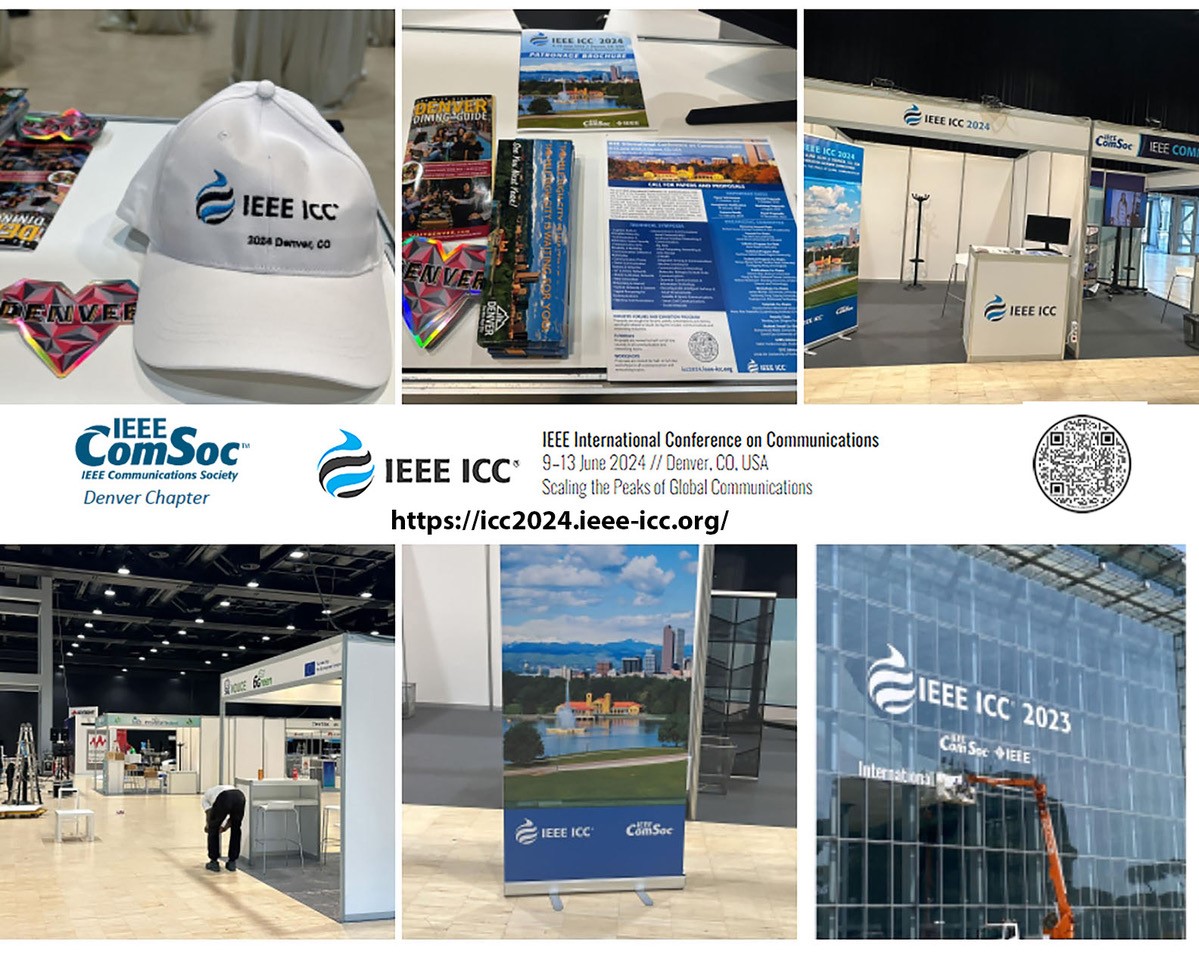
We invite you to submit a business, paper, workshop, tutorial proposal for consideration. See the attached Call for Papers (CFP) document. CFPs for symposium, workshops and tutorials require technical papers that will be published in IEEE xPlore digital library. Industry presentations, panels and workshops (not requiring publishing papers) will be solicited in the weeks ahead.
Given the convergence of computing and communication in our industry, we hope you will consider this opportunity and spread the word to your colleagues. Access conference Weblinks: Symposium Workshops Tutorials
For any question, please contact Tim Weil – General Co-Chair – ICC 2024 (Denver)720.656.9572 (m) | 240.337-1305 (f)
| R5 Sections and Formation Date |
| Section | Date | |
| 1 | Arkansas River Valley | June 20, 1994 |
| 2 | Arkansas | April 23, 1947 |
| 3 | Baton Rouge | February 5, 1955 |
| 4 | Beaumont | June 27, 1945 |
| 5 | Central Texas | May 23, 1930 |
| 6 | Corpus Christi | October 25, 1951 |
| 7 | Dallas | March 18, 1928 |
| 8 | Denver | May 18, 1915 |
| 9 | El Paso | March 7, 1940 |
| 10 | Fort Worth | January 5, 1956 |
| 11 | Galveston Bay | January 1, 1980 |
| 12 | High Plains | February 13, 2010 |
| 13 | Houston | August 7, 1928 |
| 14 | Kansas City | April 4, 1916 |
| 15 | Lafayette | November 11, 1970 |
| 16 | Lone Star | November 23, 2019 |
| 17 | New Orleans | December 8, 1933 |
| 18 | Oklahoma City | February 16, 1922 |
| 19 | Ozark | April 20, 1966 |
| 20 | Panhandle | June 12, 1947 |
| 21 | Pikes Peak | May 22, 1978 |
| 22 | Saint Louis | January 14, 1903 |
| 23 | Shreveport | January 14, 1903 |
| 24 | South Plains | May 4, 1955 |
| 25 | Southwest Missouri | February 14, 2009 |
| 26 | Tulsa | October 1, 1937 |
| 27 | Wichita | September 16, 1937 |
|
IEEE USA News |
Wanted: Licensed volunteers to help with IEEE-USA and Region 5 Pilot for a PE Refresher
Region 5 is going to pilot a PE Refresher Pilot for IEEE-USA . We have the opportunity to design and implement an exciting new and promising pilot for a program that IEEE-USA (Career and Professional Development ) and the MGA YP Committee are jointly creating.
As part of the pilot, a few subjects will be introduced to members that sign up. These subjects are, tentatively, DC/AC Circuit Analysis, Mathematics, Ethics, Economics and Power. At this time, we have an open call for an instructor in these areas to help with preparing a 2 hour webex on one of the preferred topics by creating some summary material and problems on the topic. The instructor will present the material on one evening and then be available to answer questions on the problems. We are looking to recruit the team in September and start enrolling in October. I will have an informational session in mid September with those that respond to this call. Instructors should not be concurrently supporting NCEES on any exam writing efforts. Instructors should be licensed within the US.
In addition we would be looking for a project manager that is passionate about licensing to help manage the project and expand it beyond the pilot.
This is a pilot, so the purpose is to fine tune the program and collect feedback. The informational session will help clarify format a little bit more. However you may call me at 314-941-7641 or email at bob.becnel@ieee.org.

|
IEEE MGA News |
|
Frequent Links |

